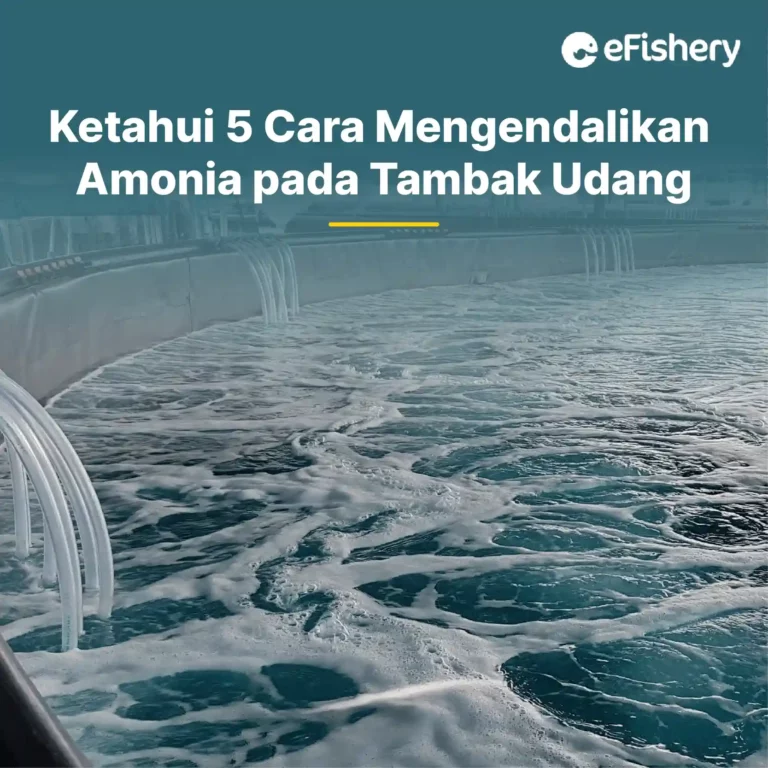Artikel Ini Telah Direview Oleh:

Anggie Nur
Magister Bioteknologi
There are many ways to remove ammonia from shrimp ponds, but it should be noted that the amount of ammonia in the waters cannot be lost 100% because ammonia in the waters plays a role in the nitrification process. Ammonia levels in waters need to be maintained so that the amount is not too high and too low.
This article discusses the impact of ammonia on shrimp and how to control ammonia in shrimp ponds. Let's check the complete information here!
What is Ammonia?
Ammonia is a nitrogenous waste produced from the accumulation of inedible feed, feces, decomposition of dead organisms, and excretion results (process metabolic waste substances that are not used by the body of the shrimp) through the gills of the shrimp. Ammonia in water exists in two forms, namely free ammonia (NH3) and ionized ammonium (NH4+). The total of both is referred to as TAN (Total Ammonia Nitrogen).
Many researchers say that ammonia is also very important for shrimp pond cultivation. Why is it important? Because ammonia can be utilized by aquatic ecosystems, namely phytoplankton. Phytoplankton play a role in fixing the process of converting dinitrogen gas into nitrogen and using nitrogen sources as nutrients for growth. Phytoplankton also plays a role in the rate of carbon fixation or organic synthesis, which is determined by measuring respiration and photosynthesis rates in the waters.
The value of ammonia levels in shrimp ponds should not be more than 0.1 ppm. High ammonia values can slow down shrimp growth, increase stress, cause decreased oxygen supply, poor FCR, low disease resistance, inhibit oxygen binding to hemoglobin, and even mass death.
In the process of shrimp farming, water quality parameters, especially ammonia, are important things for farmers to pay attention to. This is because high ammonia concentrations cause a large reduction in the supply of oxygen and changes in other water quality parameters.
Causes of High Ammonia Levels
One of the causes of ammonia levels is the result of shrimp metabolism after being given feed. Protein from the feed consumed by shrimp is broken down by shrimp and used as a source of energy for shrimp. The remainder is excreted through the gill membranes and in the urine of the shrimp. Excretion is the process of removing waste products from shrimp metabolism that are no longer used.
Apart from the shrimp metabolism process, high ammonia levels can also come from the breakdown of waste in the form of sludge or organic matter that accumulates at the bottom of the pond. Some of these waste sources are:
- Shrimp feed that is not consumed as a result overfeeding
- Shrimp manure (feces)
- Decomposition of dead organisms
The value of ammonia concentration will continue to increase along with increasing shrimp biomass in the pond. This is because the amount of feed required will also increase along with the increase in shrimp biomass.
Effect of Excess Ammonia on Shrimp Ponds
The first effect of high ammonia levels is damage to the gill tissue organs of shrimp. The gill sheets will swell, making it difficult for the shrimp to use their breathing apparatus to bind oxygen in the water. This can increase the susceptibility of the shrimp to disease which will eventually lead to the death of the shrimp.
In addition, other negative impacts of excess ammonia levels in shrimp ponds are:
- Poisoning shrimp
- Causes shrimp stress
- Causing resistance
- Increase susceptibility to disease
- Decreased appetite
- Slows down growth
- Reducing shrimp survival
How to Control Ammonia
Ammonia in shrimp ponds can not be removed 100%, because there is regular feed input which is the main nitrogen source in shrimp farming. Keeping ammonia levels low during cultivation can improve performance shrimp. However, if the amount of ammonia is too high, exceeding the recommended limit, Farmers must immediately suppress the amount of ammonia in the following way:
- Control water quality by regularly measuring ammonia levels with an ammonia meter to address the problem and prevent excessive ammonia levels from rising.
- Maintains water pH. pH can also help reduce ammonia buildup in water because toxic or un-ionized ammonia does not usually develop at optimal pH levels. The optimal pond water pH is at 6,5-9.
- Increase aeration and circulation / water exchange. Aeration will remove dissolved toxic ammonia by diffusion from water to air. In addition, water circulation/change can also dilute the concentration of ammonia and reduce water toxicity.
- Implement feeding management with eFeeder. Protein from shrimp feed is the main cause of ammonia buildup in water. The reduction in feeding can be changed to 25-50% of the total water volume. You can use an automatic feeder such as eFeeder from eFishery to optimize FCR.
- Give probiotics regularly. There are many benefits of using probiotic products in shrimp farming. Studies show that the addition of probiotics can overcome the problem of accumulation of toxic ammonia in shrimp pond water.
The long-term success of shrimp farming must be supported by a number of products designed to make it easier for farmers to manage ammonia properly. In addition, farmers must always have an ammonia measuring device available to complement the overall maintenance of shrimp farming.
Dapatkan Bantuan untuk Mengendalikan Amonia dari Ahli Budidaya!
Need Help Regarding Shrimp Cultivation Business?
Fill in your personal data in the following form. Our team will immediately contact you via the number cellphone attached. Make sure the data entered is correct.
Kandungan amonia yang berlebih dapat mempengaruhi produktivitas udang karena bisa menyebabkan penyakit bahkan kematian pada udang.
Jika Bapak/Ibu ingin langsung mendapat rekomendasi pengendalian aamonia dari ahli budidaya eFishery, Bapak/Ibu bisa langsung mengakses fitur Cultivation Consultation in app eFarm secara gratis. Selain bisa berkonsultasi langsung tentang pengendalian amonia, di fitur Cultivation Consultation, Bapak/Ibu juga bisa mengetahui tips menarik lainnya seputar budidaya udang.
Fill out the form above to consult at Cultivation Consultation!

Anggie Nur - Magister Bioteknologi
Anggie merupakan lulusan sarjana dan magister bioteknologi serta memiliki pengalaman riset di dunia perikanan khususnya udang
Questions Regarding Ammonia in Shrimp Ponds
The effect of high ammonia levels is damage to the gill tissue organs of shrimp. The gill sheets will swell, making it difficult for the shrimp to use their breathing apparatus to bind oxygen in the water. This can increase the susceptibility of the shrimp to disease which will eventually lead to the death of the shrimp.
Ammonia in shrimp farming ponds can be controlled by controlling water quality with an ammonia meter, maintaining water pH, increasing aeration and circulating/changing water, controlling feeding, and giving probiotics regularly.
- Arsad S, Ahmad A, Atika PP, Betrina MV, Dhira KS, Nanik R B. 2017. Study of Vaname Shrimp (Litopenaeus vannamei) Cultivation Activities with the Application of Different Maintenance Systems. Fisheries and Maritime Scientific Journal. Vol. 9(1):1-14.
- Ebeling J M., Timmons M., Bisogni J J. 2006. Engineering Analysis of the Stoichiometry of Photoautotrophic, Autotrophic, and Heterotrophic Removal of Ammonia Nitrogen in Aquaculture Systems. Aquaculture. Vol. 257(4):346-358.
- Jang, JD, Barford JP, Lindawati, Renneberg R. 2004. Aapplication of Biochemical Oxygen Demand (BOD) Biosensor for Optimization of Biological Carbon and Nitrogen Removal from Synthetic Wastewater in a Sequencing Batch Reactor System. Biosensors and Bioelectronics. Vol. 19:805–812.
- Jumraeni, Khaeriyah A, Burhanuddin, Anwar A. 2020. The Influence of the Disposal Model on the Accumulation of Organic Matter in Intensive Shrimp Vaname (Litopenaeus Vannamei) Ponds. Octopus. Journal of Fisheries Science. Vol 9(1): 11-18.
- Kordi M and Tancung A. 2007. PManagement of Water Quality in Shrimp Pond Cultivation. Jakarta. PT. Rineka Cipta.
- Stewart M. 2010. A Literature Review of Effects of Ammonia on Fish. Center for Science in Public Participation Bozeman. Montana.
- Supriatna, Mahmudi M, Musa M, Kusriana. 2020. Correlation between Ph and Water Quality Parameters in Vannamei Shrimp (Litopenaeus Vannamei) Intensive Ponds. Journal of Fisheries and Marine Research. Vol. 4(3):368-374.
- The Fish Site. 2015. Managing Ammonia in Fish Ponds.
